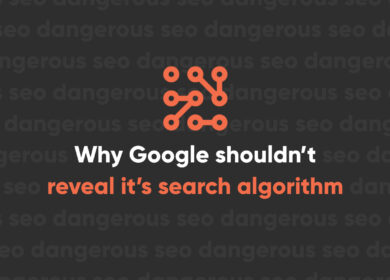
A brief history of the meta description and how to write a good one

Meta descriptions play an important role in how your webpages appear and perform on search engine results pages. The meta description itself has undergone several major changes in recent years, but its importance is one aspect that has stayed the same, if not increased. Here’s a brief history of the meta description’s wild ride through the past couple years and some tips on how to write a good one that will boost your click-through rates.
A brief history of the meta description
We’ll start by stating what a meta description is: an HTML attribute that provides a concise summary of what is on a webpage. It’s considered an essential part of on-page SEO even though the meta description by itself has no influence over rankings. It is, in essence, ad copy to get people to click on your link as it appears in search engine results (except you don’t have to pay for it). A good meta description can result in a higher organic click-through rate, which can in turn improve a page’s rankings.
For the longest time, the recommended meta description length was around 150-170 characters. It actually all depended on pixels, not characters, so it could be pretty challenging to get your meta description at the exact maximum length before Google truncated it. (It’s worth mentioning that there is technically no limit to how long your meta description can be. There’s just a limit to how much Google and other search engines will display.)
At the end of 2017, Google increased its accepted meta description length from roughly 160 characters to 300 characters. Everyone rushed and updated their meta descriptions to the longer character count to try to take up more real estate in search results even though Google clearly said not to do this. Then, back in May, Google reverted back to the previous length of 160, causing SEOs to scratch their heads while once again rethinking and rewriting their meta description strategies. This all came after Google widened its results pages from 500 to 600 pixels in 2016. It’s tough to say where the meta description is headed next, but we can provide insight into how to write an effective meta description within the current parameters.
Show your value
An effective meta description lives right in that sweet spot of both providing a clear description of your webpage and showcasing its value without being too wordy. This is your chance to get the user to your site through search. Any time you’re writing a meta description, you should ask the question, “Does this tell the user why they should visit this page?” Google generally cuts off meta descriptions around the 160-character mark, so you should make sure yours are no longer than 155 to be certain they don’t get cut off mid-sentence. There’s nothing worse tha …
Don’t come on too strong
Much like a first date, it’s important your meta description is inviting, not awkward. It is, once again, essentially an ad to attract users to your site. Just like dating. That said, using a call to action is a good idea to further engage with users and give them a reason to click. Don’t worry about overdoing keywords when writing your meta description, as those feed right into the “awkward” camp. Stick to what your page is really about. Search engines don’t use meta descriptions when ranking pages, but they do use click-through-rate, which is affected by your meta description’s performance. Get more clicks and you’ll rank more highly. Google also bolds any words from your search query that show up in the meta description, increasing visibility and rewarding you for your aptly written description.
Here’s an example of a meta description that appeared as a search result for "Minneapolis web design."

Notice how Google bolded the words from the search query. Also notice how this meta description clearly identifies what the page is about before moving into a gentle and inviting call to action. This not only leads to an optimal click-through rate but also ensures the user’s expectations are met when they land on the page.
Watch your competitors
Keep tabs on what your competitors are doing with their meta descriptions to not only remain aware of their strategies but to also make sure you’re writing a better one. You’re also competing with Google Ads in this arena, which makes the competition even more cutthroat. Take note of those ad descriptions and then write something more inviting that’s less sales-oriented and more likely to drive traffic to your page.
Don’t double up on meta descriptions
Every page on your website NEEDS to have its own meta description, just as it needs to have its own content. Meta descriptions that most accurately reflect what’s on each page will serve you and the user best in search results and in finding the information they need. However, don’t break your neck trying to write a perfect, Shakespearean description for every page. Some pages, like blog posts, don’t need much of a meta description to have a strong impact. What matters is that each page’s meta description is unique from not only your other meta descriptions but from those of your competitors.
Google might not always use your meta description
Meta descriptions are merely suggestions for what search engines should display in results, but that doesn’t mean Google will always display what you want it to. In many cases, Google won’t display the description you’ve specified. Super frustrating, right? But there is a reason for it. Google’s ultimate goal is to provide the most relevant results possible for any given query. Sometimes that might mean showing something other than what you’ve written, but as long as your click-through-rates remain high, you should have no reason to complain. Google is pretty smart - most of the time.
Mix it up
Don’t be afraid to experiment with your meta descriptions to find out what works best. If it’s been a while since you’ve update yours and you’ve seen a dip in site traffic, it might be time for a rejuvenation. But if you’re concerned about messing something up, then leave the meta description work to a digital marketing expert.
Perrill is a full-service web design and development agency that specializes in helping business websites reach their full potential. Contact us today to start doing business online the right way.





